The Beauty Created by Busy Hands
First of all, let’s clarify two important points that are still somewhat contentious in the tapestry, needlepoint and embroidery circles:
Point number one: needlepoint is not akin to tapestry, although finished needlepoint looks like tapestry.
Point number two: needlepoint is akin to embroidery, although finished needlepoint does not look like embroidery.
Now that that’s clear, let’s proceed with the patience purpose characteristic of all tapestry, needlepoint and embroidery creators worthy of their name.
So, why are tapestry and needlepoint poles apart, even though the two look alike and are frequently confused?
The needlepoint and tapestry techniques are very different. To make a needlepoint, you need to stitch thread with a needle through a stiff open-weave canvas. To make a tapestry, you need to weave thread on a vertical loom. In the end the two can look like identical twins because needlepoint designs usually completely cover the canvas. As a matter of fact, needlepoint sometimes purposefully simulated the more expensive tapestry. (That’s one more source of confusion.)
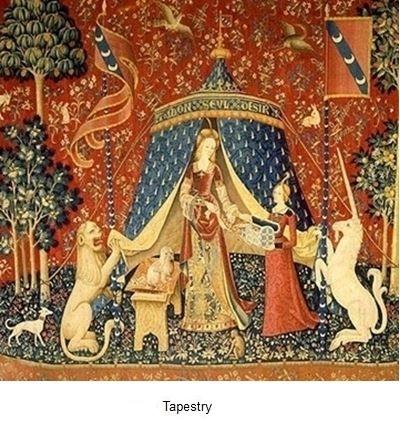
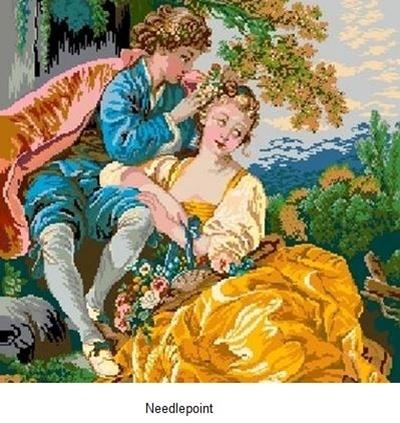
And why are needlepoint and embroidery akin, even though the two don’t look alike (and are almost never confused)?
Needlepoint and embroidery use similar techniques. Both are fashioned by means of a needle and a thread applied to a piece of fabric. Needlepoint and embroidery may even use the very same type of stitches. Still, the end results are as dissimilar as can be. That’s because embroidery is done on soft fabric and covers it only partially. Needlepoint is done on a stiff canvas and covers it completely. The aim of embroidery is to embellish a piece of fabric; the aim of needlepoint is to create new fabric.
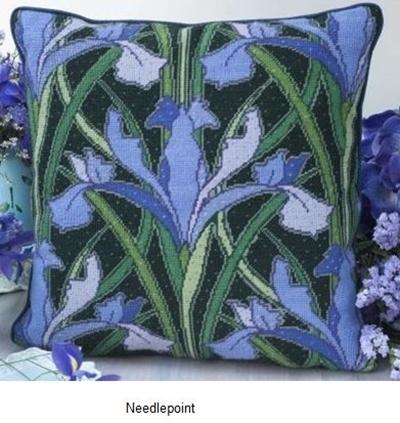
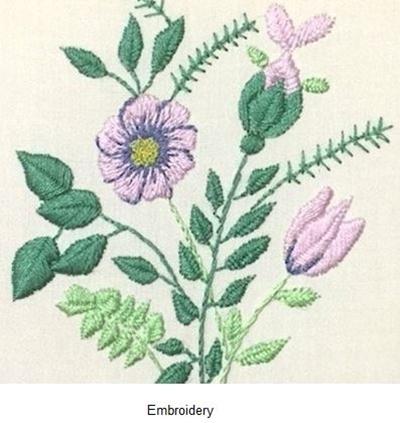
In case you thought that at least the relationship between tapestry and embroidery has to be clear-cut … think again. The famous Bayeux Tapestry is actually embroidery:
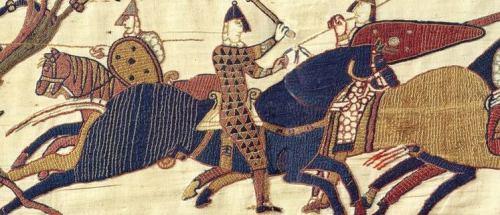
With things now as unambiguous as they can be, let’s take a closer look at each of the three “fabric arts”.
Tapestry
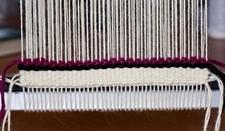 We have evidence ancient Greeks created tapestry in the 3rd century BC. However, tapestry really came into its own during the Medieval time, in the 14th and 15th century in Europe.
We have evidence ancient Greeks created tapestry in the 3rd century BC. However, tapestry really came into its own during the Medieval time, in the 14th and 15th century in Europe.
Tapestries are most often used for upholstery and as a decoration to be hung on a wall.
Tapestry is made by weaving horizontal threads (wefts) of wool, silk or other materials over and under the vertical threads (warps) on a vertical loom. From time to time, the weaver has to push down (or tamp) horizontal threads to ensure that they are close together and that they completely hide the vertical threads from view.
The tapestry pattern is created with the wefts by copying a painting of the same size, made on canvas or paper. This painting is referred to as cartoon. New wefts are introduced when a particular colour is called for and secured in place with a knot. The loose ends are then snipped off or tucked in.
This is a labour intensive and lengthy process. A skilled tapestry weaver working 35 to 40 hours a week can weave about one square meter a month.
Machine-woven tapestries were introduced in the 19th century, but these never attained the respect that the hand-woven pieces enjoy.
Today, hand-woven tapestry is to a large extent the realm of artists. Some of them use cartoons, while others improvise their design as they weave.
Needlepoint
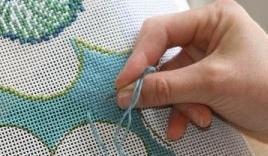 The history of needlepoint goes back thousands of years to the ancient Egyptians, who used slanted stitches to sew up canvas tents. Sample of needlepoint was found in the cave of a Pharaoh who had lived around 1500 BC.
The history of needlepoint goes back thousands of years to the ancient Egyptians, who used slanted stitches to sew up canvas tents. Sample of needlepoint was found in the cave of a Pharaoh who had lived around 1500 BC.
Needlepoint is sometimes referred to as tapestry, especially in the United Kingdom. Completed needlepoint pieces may be used as pillow tops and for upholstery, but are perhaps best known as framed pictures.
Needlepoint is done on a stiff open-weave canvas that is stretched on a frame to keep it taut during stitching. The thread used for stitching is usually wool, silk or cotton. Stitches can be plain (tent stitch) or fancy (such bargello). When worked on fine weave canvas in tent stitch, it is called petit point.
The patters in needlepoint are constructed by using threads in different colours. The stitchers can either work on a pre-painted canvas or consult a template, counting the stitches as they progress. Free-form needlepoint designs can also produce interesting finished pieces.
Traditionally, needlepoint covers the whole canvas, creating solid fabric. Modern needlepoint allows some of the unstitched or lightly stitched canvas to show through, adding a new dimension to needlepoint work.
Embroidery
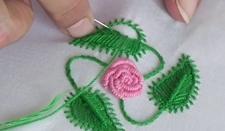 Embroidery is one of the oldest art forms. The materials and techniques used today are practically the same as the ones used thousands of years ago. The earliest known endeavours to embellish fabric by stitching thread onto it were found in China and date from the Warring States period (5th–3rd century BC).
Embroidery is one of the oldest art forms. The materials and techniques used today are practically the same as the ones used thousands of years ago. The earliest known endeavours to embellish fabric by stitching thread onto it were found in China and date from the Warring States period (5th–3rd century BC).
Throughout history, elaborately embroidered clothing, religious objects and household items were regarded as a mark of wealth and status. At the same time, embroidery persisted as a popular and widespread domestic art.
Embroidery involves working designs on cloth with laid or stitched threads. Any cloth and any thread may be used. Traditionally, wool, linen, and silk were popular choices for both the thread and the fabric. Today, cotton, rayon, and novelty yarns have been added to embroiders’ repertoire.
Embroidery can be classified according to whether the design is stitched on top of or through the fabric and by the relationship of stitch placement to the fabric. Chain stitch, cross-stitch and crewel are examples of embroidery stitches. Furthermore, holes can be cut into the fabric and embroidered. When created with white thread on white linen or cotton, this type of embroidery is known as whitework. Ribbon embroidery uses narrow silk or organza ribbon, usually to create floral motifs.
The earliest machine embroidery was produced in France in the mid-1800s. Today, new machines have been designed that allow users to create free-motion embroidery that can be applied in textile arts, quilting, dressmaking, home furnishings and more.
The dividing lines between tapestry, needlepoint and embroidery are still reasonably clear in the “domestic crafts” field, but are becoming increasingly blurred in the artistic community. The so-called “fibre artists” are creating highly individualistic work by using atypical materials and mixing different techniques.
If in doubt when required to identify a handcrafted textile art… just use the generalised term "needlework"!